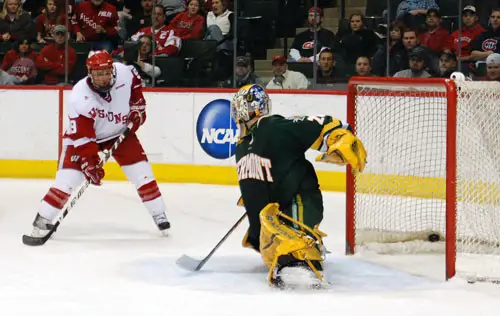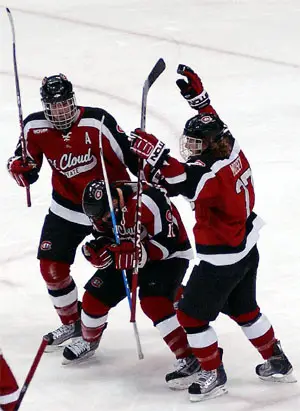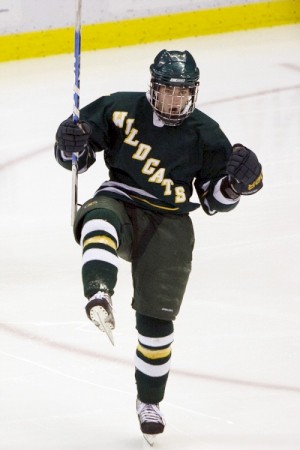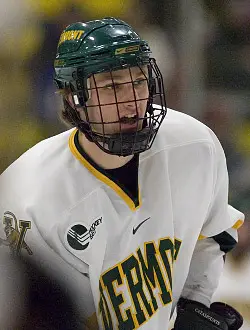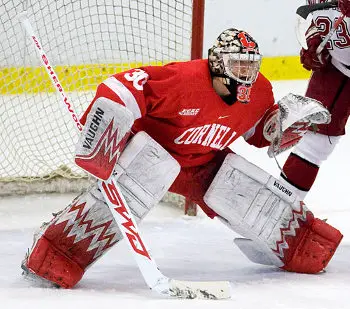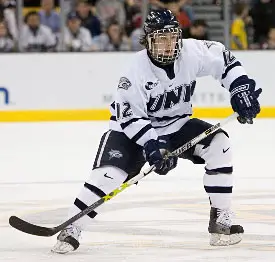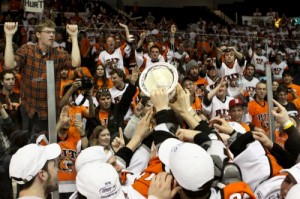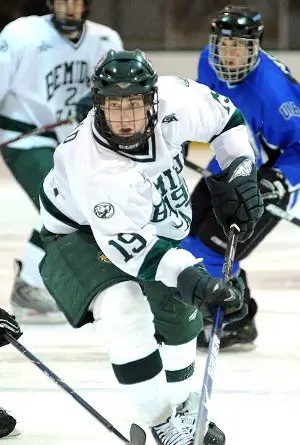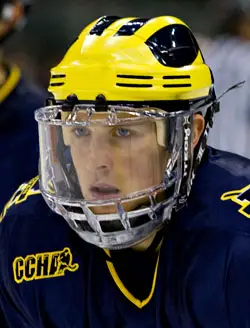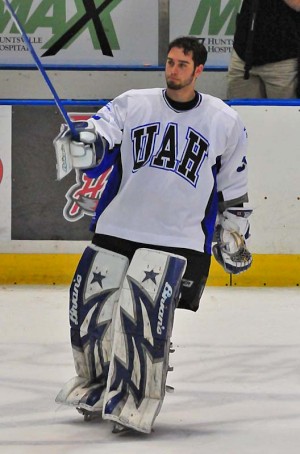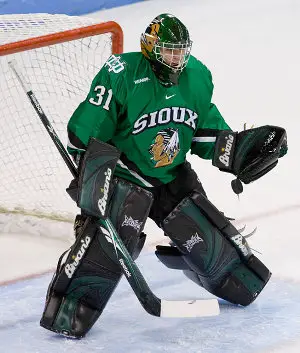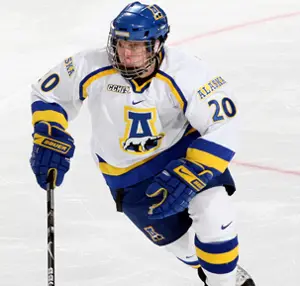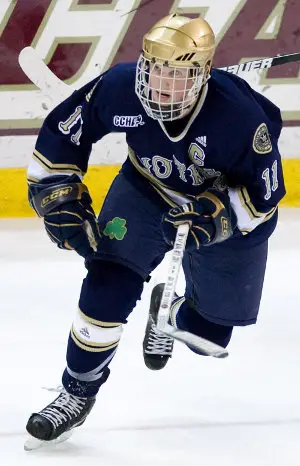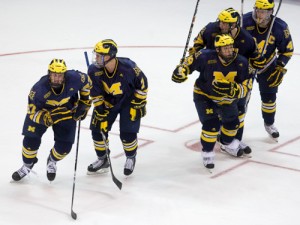Editor’s note: Here are updates from March 29 on how the 10 finalists for the Hobey Baker Award fared in the NCAA regionals, followed by the original story.
Bobby Butler, New Hampshire: 2-1–3 in 2 games played … vs. Cornell in the East Regional semifinal he was 2-1–3, plus-4, 5 shots … scored first and fourth goals … vs. RIT in the regional final he was pointless, minus-2, 3 shots, was on the ice for three even-strength goals against (1 was an empty-net goal).
Blake Geoffrion, Wisconsin: 1-1–2, 7 shots, even in a 3-2 West Regional semifinal win over Vermont … was on ice for all three Wisconsin power-play goals and one Vermont power-play goal … in the regional final, was 1-2–3 as Wisconsin won the regional with a 5-3 win over St. Cloud State, 9 shots, plus-1, was on the ice for 2 even-strength goals for and a shorthanded goal against.
Gustav Nyquist, Maine: Did not play.
Mark Olver, Northern Michigan: 0-1–1 in a 2OT loss to St. Cloud State in the West semifinal. Set up game-tying goal late in the third period. Not on ice for any goals against.
Chase Polacek, Rensselaer: Did not play.
Rhett Rahkshani, Denver: 0-0–0, 6 shots, even in a East Regional semifinal loss to RIT.
Brendan Smith, Wisconsin: 0-2–2 in Wisconsin’s West Regional semifinal win over Vermont … 3 shots and even in the game, was on ice for all three of Wisconsin’s power-play goals, not on for a goal against … 0-0–0 in West final, 3 shots, minus-1, was on ice for a SCSU shorthanded goal.
Marc Cheverie, Denver: Stopped 23 of 25 shots in a 2-1 East Regional semifinal loss to RIT … one against was a power-play goal … both goals were first shots.
Ben Scrivens, Cornell: Stopped 32 of 37 shots in a 5-1 East Regional semifinal loss to New Hampshire … 2 of 5 goals were power-play goals. All five were first shots.
Cody Reichard, Miami: Stopped 16 of 17 shots against Alabama-Huntsville in Miami’s Midwest Regional semifinal win … did not play the regional final against Michigan.
The esteemed members of the Hobey Baker Award selection committee will have their annual conference call Monday to chat about the 10 finalists, and then each member will pick his or her top five choices and submit the ballots for review.
Then we’ll find out who the Hobey Hat Trick is.
Listed below are the 10 candidates and some criteria I used in my three years on the committee to determine who really had the best season.
This season is unusual because all of the candidates come from the big four conferences (WCHA, ECAC Hockey, CCHA, Hockey East). The past three years we have had candidates from Atlantic Hockey and the CHA, and that caused some conversation as to the weight of the accomplishments of those players in a conference not as deep against the weight of a player in the WCHA where the competition is a little stiffer on a consistent basis.
There are things scouts look for in evaluating players, and some of those things are listed here. One example is how well a kid plays on the road; another is how well he plays in big games against rivals or in the postseason. There are some teams that are so utterly dominant at home (Cornell comes to mind) because of their home-ice atmosphere that it is better to evaluate their players on the road because you get a truer sense of what type of players they are without the fans intimidating officials or opposing teams.
Here are the 10 candidates, some notes — positive and negative — where applicable based on just stats (no opinion here), and a statistical breakdown. There are criteria that the committee will use to determine the winner, but how well you played is a big deal.
Check out these season-in-review capsules and decide for yourself, leaving your fandom out of it, who had the best season. The key is to be objective. Some years it is pretty clear (the Kevin Porter season was basically him wire to wire) yet the Ryan Duncan year pit Duncan against T.J. Hensick and it took a lot to make that decision. When goalies are in the mix everyone has this tendency to compare their year to Ryan Miller’s Hobey season, but that isn’t really fair to the goalies and there are three good ones on the ballot this season.
Have fun and remember that this weekend’s games are in play so if there are candidates playing they have one or two more games to solidify their credentials. This weekend counts.
Check back next week for a recap of all players who played this weekend to add to your breakdown.
Bobby Butler, New Hampshire. Senior, RW, 37 GP, 27-23–50, 20 PIM, 154 shots, +15, 4 GWGs, power play points 7-5–12, led team in shots on goal, goals, points, shots, PPGs; T-2nd with 2 SHGs.
Games with points: 28. Multi-goal games: 5. Hat tricks: 1 (4-goal game vs Providence). Multi-assist games: 5. Multi-point games: 13. Streaks: two 7-game point streaks, 13 points in the first one and 12 in the second. Two goal streaks of 4 and 5 games. Road stats: 17 GP, 11-10–21. Playoff stats: 3 GP, 2-1–3 in three game loss to Vermont in the Hockey East QF’s, was scoreless in both losses. Rivalry/big game stats: 15 GP vs Maine/VT/BU/BC, 8-9–17. Draft status: Free Agent. Notes: 1st five road points were all goals … goals in four of first six games on the road … scoreless in two games at Wisconsin … last seven games was 3-3–6 but scoreless in three of those games … had eight points in first four games including 2-2–4 against Miami at UNH … had a pair of four-point games and five three-point games.
Blake Geoffrion, Wisconsin. Senior, C, 36 GP, 25-18–43, 52 PIM, +13, 104 shots, 13 PPGs, 3 GWGs, led Wisconsin in goals.
Games with points: 26. Multi-goal games: 6. Hat tricks: 1 (vs. Michigan Tech). Multi-assist games: 2. Multi-point games: 12. Streaks: two 5-game point streaks, two 3-game goal streaks. Road stats: 11-5–16 in 15 games. 6 GP, 4-2–6. Rivalry/big game stats: 10-6 in 12 games vs Minnesota, North Dakota, Denver, Michigan and Michigan State. Draft status: 2nd round (56th overall) by Nashville in 2006. Notes: 13-5–18 on the power play … tied for 1st in PPGs in the WCHA … 2nd in WCHA conference scoring in three less games played … 58 percent on draws … 15 points in 13 GP vs. top five teams in the WCHA … two goals vs. Denver in WCHA consolation game … led WCHA in goals.
Gustav Nyquist, Maine. Sophomore, RW, 39 GP, 19-42–61, 20 PIM, +15, 7 PPGs, 134 shots (led team), tied for 1st on team in goals, led team in points and assists.
Games with points: 32. Multi-goal games: 3. Hat tricks: 0. Multi-assist games: 14. Multi-point games: 19. Streaks: point streaks of seven games (13 points), 10 games (18 points), and 7 games (16 points), assist streaks of five games (8 assists) and 6 games (12 assists). Road stats: 19 GP, 7-19–26. Playoff stats, 5 GP 1-4–5 (1-1–2 vs BC in Hockey East final), Rivalry/big game stats: 13 games against BU, BC, UNH, Vermont 5-15–20. Draft Status: 4th round (121nd overall) by Detroit in 2008. Notes: six games of 3 points or more, only went one span of being blanked in back to back games all season, 6 assists in 3 games against archrival New Hampshire, led nation with 42 assists and 61 points.
Mark Olver, Northern Michigan. Junior, C, 39 GP, 19-29–48, 48 PIM, +16, 117 shots, 2 SHGs, 3 GWGs, 6-8–14 on the power play, 48 percent on faceoffs, led the CCHA in scoring.
Games with points: 29, Multi-goal games: 4. Hat tricks: 0. Multi-assist games: 7. Multi-point games: 12. Streaks: nine-game point streak (16 points) over the month of February. Four-game goal streak (5 goals), four-game assist streak (6 assists). Road stats: 20 GP, 6-15–21. Playoff stats: 4 GP, 0-2–2. Rivalry/big game stats: 10 games against Michigan Tech, Minnesota-Duluth, Lake Superior and Michigan, 3-11–14. Draft status: 5th round (140th overall) by Colorado in 2008. Notes: scoreless in back-to-back games only once all season, points in 15 of 20 road games, shut out in CCHA title game against Michigan, four points in two home games against conference winner Miami.
Chase Polacek, RPI. Junior, C, 39 GP, 26-26–52, 40 PIM, +1, 2 SHGs, 13 PPGs, led RPI in goals, assists, points, PPGs. Led the ECAC in scoring, 2nd in the ECAC in PPGs, led the ECAC with 2-3–5 shorthanded, 13-15–28 on the power play.
Games with points: 29. Multi-goal games: 5. Hat tricks: 1 (at Dartmouth), Multi-assist games: 6, Multi-point games: 15. Streaks: 14-game point streak (24 points), five-game goal streak (5 goals) and a three-game streak (6 goals), five-game assist streak (6 assists). Road stats: 16-10–26. Playoff stats: 3 GP, 1-1–2 in three-game loss to Brown at home, scoreless in Game 3. Rivalry stats: 10 games against Union, St. Lawrence, Clarkson, Cornell, Colgate, 7-5–12 (was 4-2 against cross-town rival Union). Draft Status: Free Agent. Notes: Five goals in two games at Harvard/Dartmouth Feb. 12-13 … two assists and six shots at the GLI against Michigan and Michigan State … nine points in a four-game stretch late February … was plus or even in 27 games this season.
Rhett Rakhshani, Denver. Senior, LW, 40 GP, 21-29–50, 40 PIM, +12, 145 shots, 7 PPGs, 1 SHG, tied for 1st in WCHA scoring, tied for 3rd in WCHA in goals, 7-14–21 on the power play, led Denver in scoring and assists, 2nd on team in PPGs.
Games with points: 30. Multi-goal games: 5. Hat tricks: 0. Multi-assist games: 11. Multi-point games: 15. Streaks: Five-game point streak (8 points) and a six-game point streak (8 points), six-game assist streak (7 points). Road stats: 19 GP, 19-9–22. Playoff stats: 4 GP, 1-1–2 (scoreless in WCHA semifinal game against North Dakota). Rivalry stats: 15 GP, 9-8–17 vs Minnesota, North Dakota, Colorado College, Wisconsin. Draft status: 4th round (100th overall) by the New York Islanders in 2006. Notes: goals in seven of first eight road games played this season … six points in two games at Denver Cup vs Boston College and Nebraska-Omaha … 2-3–5 last six games played … never scoreless in consecutive games.
Brendan Smith, Wisconsin. Junior, D, 38 GP, 15-30–45, 70 PIM, +13, 120 shots, 11 PPGs, led Wisconsin defensemen in scoring, 2nd on team in power-play goals, 8th in WCHA in scoring, top defensemen scoring in the WCHA, 4th in the WCHA in assists, 11-11–22 power play points.
Games with points: 24 Multi-goal games: 3. Hat tricks: 0. Multi-assist games: 6. Multi-point games: 13. Streaks: five-game point streak (9 points) and a seven-game streak (15 points). Seven-game assist streak (10 points). Road stats: 17 GP, 9-10–19. Playoff stats: 4 GP, 5 assists. Rivalry stats: 15 games played against North Dakota, Minnesota, Denver, CC, Michigan and Michigan State, 6-7–13. Draft Status: 1st round (27th overall) by Detroit in 2007. Notes: three-assist game against New Hampshire and four-assist game against Michigan Tech … back to back multi-point games against St. Cloud State and Michigan State.
Marc Cheverie, Denver. Junior, G, 34 GP, 24-5-3, 69 goals allowed, 953 saves, 6 shutouts, .932 save percentage, 2.06 goals-against average.
Had consecutive win streaks of 3 (twice), 4, and 9 games (included a sweep at North Dakota and a sweep at Minnesota State). Allowing one goal: 7. Allowing two goals: 8. That means 21 of 34 games he allowed two goals or less. Allowing 4 goals or more: 5 (once was in the WCHA semifinals against North Dakota). Road record: 11-3-1, 26 goals allowed and 4 shutouts. Playoff stats: 2-1, 8 goals allowed on 75 shots. 30-plus-saves games: 11. 40-plus-saves games: 2 (won both). Rivalry/big games: 8-3-2, 1 no-decision (pulled vs. Wisconsin in WCHA consolation game) vs Minnesota, CC, Wisconsin and North Dakota. Notes: 2nd nationally in save percentage, 12th in minutes played, second in shutouts (behind Ben Scrivens). Top goals-against average in the WCHA, top save percentage in the WCHA … Denver had the second best team GAA in the WCHA at 2.42. Draft status: 7th round (193rd overall) by Florida in 2006.
Ben Scrivens, Cornell. Senior, G, 33 GP, 21-8-4, 58 goals allowed, 863 saves, .937 save pct, 1.77 GAA, 7 shutouts.
Streaks: two of 3 wins in a row, one of 4 wins in a row. 1 goal allowed: 8. 2 goals allowed: 8. 23 of 33 starts allowed 2 goals or less. 4 or more allowed: 3. Road record: 9-5-2, 28 goals allowed. Playoffs 4-0, 1 goal allowed, 230:30 minute shutout streak currently active. 30-plus-save games: 8. 40-plus-save games: 1 (52 saves in an OT loss at home to Yale). Rivalry/big games: 9-1-1 vs Harvard, Colgate, Clarkson, BU (at Madison Square Garden) and North Dakota. Notes: Led the NCAA in GAA, save percentage, shutouts. 14th in minutes played. Draft status: Free Agent
Cody Reichard, Miami. Sophomore, G, 25 GP, 18-4-3, 44 goals allowed, 538 saves, 5 shutouts, .924 save percentage, 1.79 GAA.
Streaks: One 5-game win streak, one 6-game win streak. 1 goal allowed: 6. 2 goals allowed: 6. Total: 17 of 25 starts 2 goals or less allowed. 4 or more allowed: 3. Road record: 10-2-2, 23 goals allowed, 3 shutouts. Playoffs: 1-2, 12 goals allowed, pulled in the CCHA semifinal loss to Michigan. 30-plus-saves games: 2. 40-plus-saves games: 0. Rivalry/big games: 9-2-1 vs Michigan, MSU, Bowling Green, Miami, New Hampshire and Notre Dame. Notes: Tied for 6th nationally with 18 wins, played 10 less games than two other 18 game winners and 13 less than the other (Michigan’s Bryan Hogan, Northern Michigan’s Brian Stewart, Alaska’s Scott Greenham) … .924 save percentage was 5th in the NCAA and 1.79 was 2nd in the NCAA.
